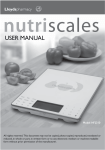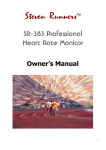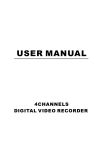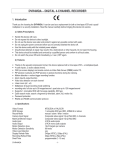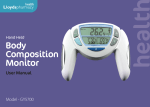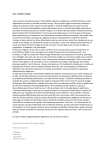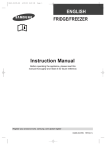Download Heart Rate Monitor
Transcript
Heart Rate Monitor K901B User Manual Please read this user manual carefully before using the product Contents Introduction P.01 The Lloydspharmacy Heart Rate Monitor P.02 Using The Lloydspharmacy Heart Rate Monitor P. 04 Responsible Use of the Lloydspharmacy Heart Rate Monitor P. 11 Technical Information P. 12 Care and Maintenance P. 13 Diet & Lifestyle Information P. 15 Q & A – Frequently asked questions P. 25 Thank you for selecting the Lloydspharmacy Heart Rate Monitor. Exercise isn’t just for top athletes. Any exercise that gets your heart rate above resting levels can help to improve your fitness, be it walking, swimming, cycling or jogging. Exercise isn’t just for the young – everyone can do their bit to keep fit throughout life. When you start to exercise, your heart rate increases in proportion to the intensity of the exercise. The Lloydspharmacy Heart Rate Monitor allows you to measure your heart rate whilst exercising so that you can alter the intensity of your exercise to ensure a safe and efficient workout. If you have not exercised for a while, we recommend that you start gently and build up to moderate activity gradually. If you have any health problems, you should speak to your Doctor before starting an exercise programme. Before using the Lloydspharmacy Heart Rate Monitor, please read the instructions included in this user manual. P.1 The Lloydspharmacy Heart Rate Monitor Pack Includes: Heart rate monitor watch Chest transmitter User manual 2 x CR2032 batteries Your Lloydspharmacy Heart Rate Monitor consists of the following items: The wrist unit: This displays the time and date, current, average and maximum heart rate, 1/100 second stopwatch, alarm and backlight. The chest transmitter: This should be worn during exercise. The transmitter contains electrodes that detect your heart rate continuously and transmits the information to the wrist unit. The elastic strap holds the chest transmitter in place. P.2 Wrist Unit Features: EL Backlight SET/RESET/- Alarm Time and date Heart Rate MODE START/STOP/+ P.3 Using the Lloydspharmacy Heart Rate Monitor Getting set up Remove the peel-off labels before use. Time and date function To set the time and date, press the “mode” button. 1. Press and hold the “set/reset/-” button for 3 seconds until the year flashes. 2. Set the year by pressing the “set/reset/-” button (to decrease) or “start/stop/+” (to increase). 3. When the year is set, press the “mode” button. The month will flash. Follow step 2 above to set the correct month. 4. Follow steps 2 and 3 to set the date, hour and minutes. 5. Press “mode” twice to confirm your settings. Please note that the day will be displayed automatically on the bottom of the LCD display. 6. Press “set/reset/-” button to select between 24 or 12 hour format. “ ”represents am and “ ”represents pm Using whilst exercising There are two sensors on the inside of the chest transmitter for detecting your heart rate. Before attaching the chest transmitter, wet these sensors lightly with cool water to ensure an easier and faster detection. See diagram below. Attach the transmitter around your chest, positioning it correctly - please see diagram below. P.4 Using the Lloydspharmacy Heart Rate Monitor Current Heart Rate 1.Press the “mode” key until the present heart rate function is displayed below the time/date function. “ ” will be displayed. 2.“ ” will be displayed followed by your present heart rate. Maximum Heart Rate Maximum heart rate will record your highest heart rate reading. Any new higher reading will replace the previous maximum record. Press “mode” until “ ---- Max” is displayed. This will show your maximum heart rate. Average Heart Rate Average Heart Rate records your average heart rate reading. Press “mode” until “ --- AVG” is displayed. This will show your average heart rate. Stopwatch Press “mode” until you reach the stopwatch function. To start the stopwatch press the “start/stop/+” key. To stop the stopwatch press the “start/stop/+” key. To reset, press the “set/reset/-” key. P.5 Using the Lloydspharmacy Heart Rate Monitor Alarm Press “mode” until you reach the alarm function. Example: 4:02 1.Press and hold the “set/reset/-” button for 3 seconds, until the hour flashes. 2.Set the hour by pressing the “set/reset/-” button (to decrease) or “start/stop/+” (to increase). 3.Press the “mode” button again until the minute flashes. Follow step 2 to set the minutes. 4.Press the “mode” button to confirm the alarm time settings. 5.To activate the alarm press the “set/reset/-” button until is displayed. To turn the alarm off, press any button (except the EL backlight button). P.6 Using the Lloydspharmacy Heart Rate Monitor Target heart rate The fastest heart rate that you can reach is known as the maximal heart rate. It is highest in childhood and gets lower with age. The maximal heart rate of a 20 year old when exercising is approximately 200 bpm, whereas a 60 year old has a maximal heart rate of approximately 160 bpm. To work out your own maximal heart rate you need to do a simple calculation. You subtract your age in years from the maximal heart rate of 220 bpm, e.g. if you are 40 years old then your maximal heart rate will be 220-40 = 180 bpm. To ease yourself into exercise, it is best to have substantial warm up and cool down sessions. Please note: These target heart rates apply only to adults. P.7 Using the Lloydspharmacy Heart Rate Monitor Heart Rate Training Intensity Zones (chart) AGE Maximal Heart Rate (MHR) Light Intensity 60-75% of MHR Moderate Intensity 75 - 85% of MHR 20 200 120 150 150 170 25 195 117 146 146 166 30 190 114 143 143 162 35 185 111 139 139 157 40 180 108 135 135 153 45 175 105 131 131 149 50 170 102 128 128 145 55 165 99 124 124 140 60 160 96 120 120 136 65 155 93 116 116 132 Heart Rate Training Intensity Zones (graph) P.8 Target heart rate & your needs Working your heart to one of the following intensity levels provides different benefits to your fitness. Light Exercise Maintain Healthy Heart / Get Fit Intensity of Light exercise is ideal 50-60% MHR for people who are new to exercise or are starting again after a lay off Weight Lose Weight / Management Burn Fat Intensity of This level of exercise is 60-75% MHR ideal for people who want to lose weight. At this level of intensity, fat is the main source of energy for the body. Exercising at this level of intensity will therefore burn fat. It will also improve your fitness and endurance Aerobic Base Increase Stamina & Intensity of This level of exercise will Aerobic Endurance 75-85% MHR help get your body used Building to exercising at a faster pace. Your lung capacity will improve. This intensity is normally at the fastest pace that can be maintained comfortably. This level of intensity will also help with weight control Maintain Excellent Intensity of Hard, intense bursts of Optimal Conditioning Fitness Condition 85-90% MHR exercise should be used sparingly by fit people to improve their endurance. It will also improve the body's tolerance to lactic acid P.9 Using the Lloydspharmacy Heart Rate Monitor Lactic acid is produced during exercise. This is what causes the intense pain or ‘burn’ felt during exhaustive exercise, thereby reducing exercise efficiency. Training can help to reduce this effect and the burning sensation that accompanies it. Exercising with a Heart Condition If you have a heart condition or suspect that you have a heart condition, you should always consult your doctor before starting an exercise programme. During exercise your heart rate should reach no more than 60-75% of the maximum heart rate that you have calculated. To ease yourself into exercise, it is best to have substantial warm up and cool down sessions. Although it may be important for athletes to know about 'predicted maximum heart rates' and the need to reach a particular heart rate when they are exercising, this should not be the case for anyone who is on medication. Many drugs used to treat heart conditions can slow down the heart rate and prevent the heart from responding as it normally would. So, if you are taking medicines it may be easier and more effective to do the talk test while you are walking - if, while you are walking, you feel warm and are breathing more heavily than normal but you can still talk, then you are walking at the right pace. P.10 Responsible Use of the Lloydspharmacy Heart Rate Monitor To get the most out of the Lloydspharmacy Heart Rate Monitor, you should consider the following questions before going into a new exercise regime. If you answer yes to any of them, we recommend that you consult either your Doctor or your local Lloydspharmacist. Do you have high blood pressure? Are you taking any blood pressure or heart medication? Do you have high cholesterol (LDL)? Do you have asthma or other breathing problems? Are you a heavy smoker? Do you use a pacemaker? Are you pregnant? Cautions If you experience discomfort or pain at any time when exercising, it is recommended that you stop the exercise, or reduce the level of exercise to a more comfortable, lighter intensity. P.11 Technical Information Product Name Model Number Power Supply Power Consumption Storage Environment Heart rate watch Battery Type Battery Life Water Resistance Watch Accuracy Wrist Strap Material Back Cover Material Accuracy of Heart Rate Measurement : : : : : Heart Rate Watch K 901B DC 3V ~11 - 13.5 UF in time mode Room Temperature CR2032 1 year depending on usage 100 feet / 30 meters 3.5 sec / day (max) Polyurethane (PU) Stainless Steel +/- 3-5 bpm Note: Heart Rate is displayed as the number of heartbeats per minute (bpm) Chest Transmitter Battery Type CR2032 Battery Life 1 year depending on usage Case Material Acrylonitrile Butadiene Styrene (ABS) Water Resistance Shower Proof Buckle Polycarbonate (PC) Straps Nylon, Polyester and Natural Rubber Note: The chest transmitter should not be used whilst swimming. Limit Values Chronometer Heart Rate Limit 29hr 59min 59sec 35 to 250 (max) P.12 Care and Maintenance Replacing batteries Please read the following precautions before replacing the batteries: Unscrew the battery cover and replace the battery. IMPORTANT: Ensure the battery is inserted observing the correct polarity, to avoid damaging the unit. Wrist Unit The battery compartment is located on the back of the watch face. Using a small screwdriver, unscrew the four small screws to remove the cover. Carefully remove the old battery and dispose of it following the battery manufacturer's instructions. Insert the new battery, observing correct polarity. Replace the cover and secure with screws. Chest Transmitter The battery compartment is located on the inside of the belt. Insert a coin into the slot on the battery compartment and turn it clockwise (OPEN). Carefully remove the old battery and dispose of it following the battery manufacturer's instructions. Insert the new battery, observing correct polarity. Replace the cover by inserting a coin into the slot and turning it anticlockwise (CLOSE). P.13 Care and Maintenance Battery precautions Batteries should be handled under adult supervision. If batteries leak and come into contact with the skin or eyes wash well with clean water. Dispose of batteries safely according to battery manufacturer’s instructions. Keep batteries out of reach and sight of children. If swallowed, consult a doctor immediately. Non re-chargeable batteries must not be recharged. Different types of batteries and old and new batteries must not be mixed. The supply terminals must not be short circuited. Exhausted batteries should be removed from the unit. Handle the monitor and chest transmitter with care. To clean the chest transmitter, use a mild soap and water solution and dry carefully with a soft, dry cloth. Do not use any abrasive material, alcohol or cleaning chemicals. To clean the monitor, wipe with a soft cloth. Store monitor and chest transmitter in a cool, dry place. Keep away from direct sunlight or heat for extended periods of time. P.14 Diet & Lifestyle Information Being overweight or obese is a growing problem in the UK. There are eighteen million sick days taken and thirty thousand deaths a year due to weight related issues. On average, deaths related to obesity shorten the life by nine years. The number of obese and overweight people has trebled between 1980 – 1998. Today, around two thirds of men and half of all women are overweight or obese. The health implications of being overweight or obese are well documented. Some of the most common problems linked to being overweight or obese are heart disease, type 2 diabetes, hypertension and osteoarthritis. In general, weight issues are caused by an excess of fat. It is widely accepted that by getting down to a healthy weight you will minimise those potential health risks. The best and safest results for weight loss come from the combination of a balanced diet and regular exercise. An additional benefit of this is that it is sustainable. There are two basic ways to reduce weight: increase exercise to burn calories and cut down the calories you eat. P.15 Diet & Lifestyle Information Healthy eating tips Eat lots of fruit and vegetables and high fibre foods to help keep your diet healthy, balanced and satisfying Try to enjoy a variety of foods in your diet Make one or two positive changes to your diet each week and build on them Drink plenty of water to prevent getting dehydrated (6-8 glasses/day). A glass before a meal may help to reduce the appetite Spread your calorie intake throughout the day by eating regular meals and avoid heavy meals in the evening Eat regular meals, starting with breakfast. People who have breakfast find it easier to control their weight Choose lower fat foods and check portion sizes, especially when eating out Try to get hold of the menu in advance when eating out, choose healthier options and avoid rich sauces, fried foods and pastry. Pick fruit, sorbet or ice cream as desserts When days do not go to plan, do not give up. Think positively and ‘get back on track’ right away. The occasional lapse is very normal Cut down on salt by adding less to food when cooking or during your meal Divide your plate in half, cover half with vegetables and share the remaining half equally between starchy foods and meat or fish P.16 Diet & Lifestyle Information The balance of good health There are eight key tips for a healthy diet that you may like to consider: Enjoy the food Eat a variety of different foods Eat the right amount to be a healthy weight Eat plenty of foods rich in starch and fibre Eat plenty of fruit and vegetables Do not eat too many foods that contain a lot of fat Do not have sugary foods and drinks too often Drink alcohol in moderation The idea of a balanced diet is to include foods in the right proportions. The aim is to get all the nutrients your body needs whilst maintaining a healthy weight. It is not a case of having roughly equal measures of everything. There should be a lot of some foods and just a little of others. The Balance of Good Health divides food into 5 different groups: Bread, other cereals and potatoes (starchy foods) Fruit and vegetables Milk and dairy foods Meat, fish and alternatives Foods containing fat and foods containing sugar P.17 Diet & Lifestyle Information Bread, other cereals and potatoes This group contains Starchy foods such as; breakfast cereal, pasta, rice, oats, noodles, maize, millet, cornmeal, potatoes, yam and all types of bread. Contrary to popular belief, these foods are not fattening. In fact, they contain about half the amount of calories as the same weight of fat or oil. It is what we add to foods in this group that makes them fattening, so try to avoid: Having them fried too often (e.g. chips or roast potatoes) Adding too much fat (e.g. butter/oil or margarine) Adding rich sauces and dressings (e.g. creamy sauces on pasta) Try to eat wholegrain, wholemeal or high fibre versions where possible. This is because they contain more fibre. There are several advantages to eating foods rich in fibre: It prevents constipation It helps to protect against bowel problems, including cancer It helps control the appetite by keeping a person fuller for longer Soluble fibre such as that in oats has also been shown to lower cholesterol levels Tips for increasing complex carbohydrates and fibre: Make sure a starchy carbohydrate such as breakfast cereal, potato, bread, rice or pasta is eaten at each meal To increase the intake of fibre, go for wholegrain varieties Replace some of the meat in soups and casseroles with lentils, pearl barley, beans or peas P.18 Diet & Lifestyle Information Fruit and vegetables Eating a least five servings of fruit and vegetables a day is an important element of a healthy eating plan. As part of this quota a person can have fruit or vegetables that are: · Fresh, Frozen, Canned, Dried, Juiced * *A glass of fruit juice counts towards your 5-a-day target,but it only counts as one portion however much is drunk in a day. It is recommended that a person eats a wide variety of fruit and vegetables and tries to avoid adding fat or rich sauces to vegetables or adding sugar or syrup to fruit. Milk and Dairy foods This group includes: · Milk* · Cheese** · Yoghurt and fromage frais** · Eggs *Use semi-skimmed or skimmed milk **Choose lower fat versions whenever possible. This means low fat cheeses and low fat or ‘diet’ yoghurts and fromage frais. This group does not include butter or cream, which are included under the section for fats P.19 Diet & Lifestyle Information Meat, fish and alternatives This food group includes; · Red meat · Poultry · Fish* · Pulses** · Beans** · Nuts · Seeds · Soya products · Vegetable protein foods such as quorn *Fish includes frozen and canned fish such as sardines and tuna, fish fingers and fish cakes. Aim to eat at least one portion of oily fish such as sardines or salmon each week, as these contain oils which will benefit the heart and help to keep it healthy. ** Beans and pulses are good alternatives to meat as they are naturally very low in fat. Choose lower fat versions whenever you can- e.g. by cutting the fat off meat, removing the skin from poultry and eating fish without the batter. Many of these foods naturally contain fat so try to cook them without adding any oil or extra fat. P.20 Diet & Lifestyle Information Fats These include: Margarine, butter, other spreading fats and low fat spreads, cooking oils, oil based salad dressings, mayonnaise, cream, chocolate, crisps, biscuits, pastries, cakes, puddings, ice cream, rich sauces and gravies. These foods are all high in calories and need to be controlled carefully if a person is to lose weight or fat. Although some fats are better for our health than others, they all contain the same amount of calories and so it is important to limit sources of all fats. We all need to include some fat in our diet and it helps to make foods more interesting and enjoyable. There are three main types of dietary fat- saturated, monounsaturated and polyunsaturated and most foods contain a mixture of these three. Food labels often give the type of fat present in food, as well as the amount. Saturated fats are the most damaging to your health and are usually found in animal products such as meat, butter, milk and cheese. Monounsaturated and polyunsaturated fats are referred to as ‘healthier’ types of fat, as they can potentially lower your blood cholesterol levels and reduce the tendency for blood to clot. These are largely found in oils and fish. Oily fish such as salmon, sardines and pilchards are rich in omega-3 fatty acids, which are unsaturated fats. Current recommendations are that we should aim to eat fish at least twice a week, including one portion of oily fish. In smaller amounts, this type of ‘healthier’ fat can also be obtained from plant foods such as rapeseed, walnuts, soya, flax and linseed oils. P.21 Diet & Lifestyle Information Sugars These include: Soft drinks, sweets, jam, cakes, puddings, biscuits, pastries, ice cream. Sugary foods often contribute few vitamins and minerals to the diet and are high in calories. Artificial sweeteners make it easier to cut down on these foods without missing out. Eating sugar too often can lead to tooth decay and weight gain. Here are some tips to help reduce sugar intake: Avoid foods with high sugar content. Remember sugar has many different forms and may be referred to as sugar, glucose, sucrose, dextrose, brown sugar, fruit fructose, cane sugar, honey, molasses, treacle, syrup and many more Use artificial sweeteners in tea and coffee if you need them Use less sugar when cooking Buy ready made low sugar desserts Substitute sugar coated cereals with high fibre and wholegrain ones Buy tinned fruit in natural juice rather than syrup Cut down on the amount of biscuits, cakes, honey, jam and marmalade that you eat Cut down on all kinds of sweets and chocolates Choose low calorie soft drinks or unsweetened fruit juice diluted with water P.22 Diet & Lifestyle Information Physical Activity Regular physical activity, combined with healthy eating, is known to be the best method of losing and maintaining a healthy weight, as well as improving your overall health. There are numerous benefits of being more active. Benefits of exercise More energy and greater stamina Stronger, more toned muscles for a better shape and appearance Lower risk of heart disease and stroke Lower risk of osteoporosis Reduced risk of diabetes Improved blood pressure and cholesterol levels Less breathlessness Feeling less stressed Better quality of sleep Better self esteem Helps speed up weight loss and helps maintain target weight Any extra physical activity benefits health and fitness. A good target is to aim to do 30 minutes each day. Once you get started you will identify more and more opportunities to be active and this will increase the chances of successfully losing weight and keeping it off. The 30 minutes exercise does not have to be done all in one go. Two lots of 15 minutes, or even three lots of 10-minute bursts of activity, may be just as effective as 30 minutes of continuous activity. Everyone should try to fit this into their normal routine and once established, aim to gradually build this up to 60 minutes a day. P.23 Diet & Lifestyle Information A good way to start getting active is to carry on with an everyday routine, but do things in a way that requires a bit more energy, and then build this into a daily lifestyle. You should always check with your doctor about the best form of activity if: You have not been active for some time You suffer from health problems You have heart trouble You have high blood pressure You have experienced unexplained chest pains You have experienced dizziness or fainting You have a bone or joint problem that could be made worse by exercising You have concerns about becoming more active P.24 Q & A – Frequently asked questions How do I lose weight and keep it off? Forget strict diets. Instead make small changes to what you are doing now. These changes may include regular meals, cutting down on foods high in fat and sugar, not snacking in front of the TV or increasing the amount of vegetables and fruit you eat. Start with 2 or 3 goals, keep these up for a few weeks until they become a habit, then choose another 2 or 3 and do the same again. It will be more effective in the long term to lose weight this way but do not expect to lose weight quickly - 1/2 lb (0.5/1.0kg) approximately per week is normal.You will also find it easier to lose weight if you are also more physically active. I eat just one meal per day, but still can’t lose weight. What can I do? Eating more regularly, for example three smaller meals a day, can help to control your eating and help you lose weight. Plan your day around what healthy meals or snacks you will have, thinking about what you will do when you are away from home. Often it is easier to control what you eat by taking something healthy with you from home. I’ve lost some weight, but now this has stopped. How can I start losing weight again? Weight loss can be slower than you would like and you may not lose weight some weeks. Using a food and activity diary can highlight areas where you may be able to make more changes, discuss your diary with the pharmacy staff. People who are more physically active find it easier to lose weight, so you may want to set this as one of your goals. P.25 Q & A – Frequently asked questions I have an under-active thyroid gland, can I still lose weight? This is an uncommon condition, but once it is under control with the use of medication from your doctor, it should not be any harder for you to lose weight. I have diabetes, is there any special advice for weight loss? Losing just a small amount of excess weight, for example 5-10%, can help to improve control of your diabetes. Healthy eating for diabetes is really no different to healthy eating for everyone else. If you are taking tablets or insulin for your diabetes you should speak to a doctor, dietician or diabetes nurse before making major changes to your diet and physical activity level. The pharmacist will then be able to help you. How do I get a referral to see a registered dietician? Ask your doctor or practice nurse to refer you to an NHS dietician in your area. Alternatively, you can pay to see a dietician privately. For details of how to contact one in your area visit www.bda.uk.com or www.dietitiansunlimited.co.uk. Is it true that when you diet your metabolism slows down? Yes, but not as much as people think. You will still be able to lose weight, and you can help to offset this decline by eating regularly and increasing your activity level. Should I be taking vitamin and mineral supplements? Provided you are eating a healthy balanced diet there is no need to take vitamin and mineral supplements. However, if you would like to take a supplement, speak to the pharmacy staff about choosing one which provides no more than the RDA (Recommended Daily Amounts) of vitamins and minerals. P.26 Q & A – Frequently asked questions What is the best type of exercise to help with weight loss? There are so many benefits to being more active that it does not matter too much what sort of exercise you choose! Start by aiming for 30 minutes a day of moderate activity, such as walking, gardening, or housework. Then aim for 60 minutes each day. If you are not used to doing any activity, build-up to the 30 and 60 minute targets gradually. ‘Moderate’ means you should be feeling warmer and breathing more deeply, but not so you can’t talk! See pages 8 and 9 for information on intensities. NOTE: All information is correct at time of printing P.27 Lloyds Pharmacy Limited, Coventry CV2 2TX www.lloydspharmacy.com































